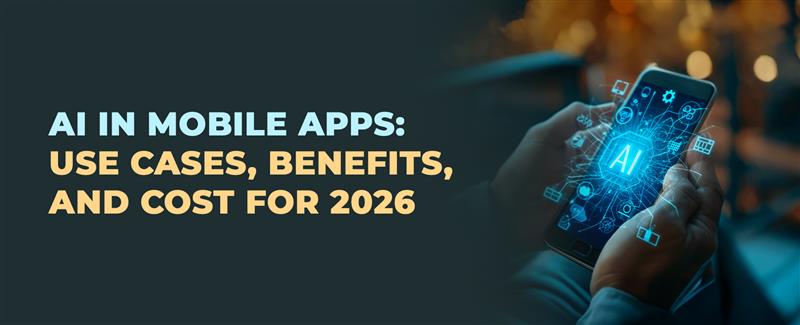Generative AI in e commerce: Use cases and implementation
22 Nov 24 

Customer behavior has changed a lot in recent years. After COVID-19, more people shop online and want their digital shopping to feel as good as shopping in stores. While online shopping is growing fast, it creates new problems for businesses. They find it hard to handle large product lists, give each customer a personal experience, create good content, and answer customer questions quickly.
Generative AI is one such powerful tool that’s turning these challenges into chances for growth. This technology is making online shopping better by creating new virtual experiences and product ideas that shoppers enjoy.
In this blog, we’ll look at how generative AI is changing online shopping and its huge potential. We’ll show how brands can benefit from it and use it well. Want to know more? Keep reading.
What is Generative AI in eCommerce?
Generative AI in online shopping uses artificial intelligence to create attractive content, data, or designs that make shopping online better.
We call it generative because it can create new things, not just study existing information. Generative AI uses machine learning to generate videos, images, and data. In online shopping, it helps create personal content, suggest products, write product descriptions, and make special videos about products and services.
A research company, Gartner, made an interesting prediction about this growing technology. They said that by 2030, generative AI will create 30% of all marketing messages, up from just 2% in 2022. This change is making the global AI market, worth $207 billion, very attractive for investors.
8 Ways Generative AI is Transforming the eCommerce Industry
As time passes, online shopping keeps using new technologies to stay ahead and give customers more value. Generative AI, which uses advanced machine learning, has become very popular among business owners and solution providers. Online businesses are now looking at all the ways generative AI can help them grow.
Customized Recommendations and Targeted Marketing Approaches
Using smart technology, Generative AI looks at lots of customer information like what they buy, where they browse, where they live, and what they do on social media. This helps stores suggest products that each customer might like. People enjoy getting special suggestions, which makes them happier with the store and more likely to buy things.
Think about Netflix as an example. When we make our Netflix profile, the AI watches what shows we like. Then it suggests other shows and movies we might enjoy based on what we’ve watched before. It’s really helpful, right?
Visual Search and Virtual Fitting Technologies
Visual search is a really useful tool. You can take a picture of something you like, and the AI will find similar items in the store. This saves you from having to look through thousands of products to find what you want.
For example, Myntra, an online clothing store, has this feature. Just upload a picture of clothes you like, and Myntra shows you similar items they sell.
Automated Content Creation
Generative AI helps stores create different kinds of content automatically, like product descriptions, pictures, videos, posts, and catalogs. The content is really good quality too. The AI studies different writing styles and creates engaging content much faster than people can.
The AI can also write posts for marketing and social media that sound natural and interesting. Big online stores like Alibaba already use AI to write descriptions for millions of products on their website. These AI-written descriptions are detailed and give customers all the information they need about products.
Dynamic Pricing with Generative AI
Generative AI looks at market trends, competitor prices, and other things like weather and holidays that might affect prices and what people want to buy. It changes prices automatically based on this information. This helps stores set the best prices for their products.
Airlines are a good example of this. Have you noticed how flight prices change often? The price might be different depending on when you book, if it’s a holiday, what season it is, or how many people want to fly. These price changes happen automatically based on these different factors.
More online stores are starting to use Generative AI to make more money and offer good prices to their customers.
Streamlined Supply Chain Management
Supply chain management means keeping track of products, handling orders, and figuring out what customers will want to buy. Doing this by hand is hard work, but AI technology can make it much easier. The AI uses smart computer programs to look at things like weather reports, what’s popular in stores, what customers want, and how well things are selling to make good predictions. This helps online stores keep the right amount of products in stock, make sure items are available when needed, deliver them on time, and keep everything running smoothly.
Let’s look at Amazon as a good example. This big online store uses AI to manage its products, plan delivery routes, make distribution work better, and improve how they do business to give customers the best service possible.
AI-Powered Chatbots and Customer Service
Customers like getting help right away, and stores that can do this are usually more successful. But when customer service teams get thousands of questions every day, it’s hard to answer everyone quickly through chat, phone, or email. One person can only help so many customers at once. AI chatbots can make this easier by understanding customer questions and giving correct answers automatically.
Learn how to build an AI-powered chat bot-The ultimate guide 2024
The AI also studies how customers behave, what they buy, and their past conversations, so it can give personal help to each customer, making their shopping experience better. Plus, chatbots can help customers 24 hours a day, even when the store is closed. This means customers can get help whenever they need it, no matter where they are.
Innovative Design and Product Development
AI can help create beautiful pictures, product catalogs, and videos by helping designers come up with new ideas. When designers give the AI some basic rules about what they want, it can suggest many different designs. Designers can use these AI ideas to inspire their own new creations for the store.
AI tools can also make detailed test versions of products based on what’s needed. These can include 3D models, moving pictures, and virtual views that help designers see what the final product will look like early on. This saves time and makes it easier to improve designs quickly.
Security Enhancements and Fraud Prevention
AI is really good at finding fraud by looking through lots of information to spot unusual patterns that might mean someone is trying to cheat. These AI systems can check many money transactions right away and notice if something strange is happening.
For example, in online stores where lots of money moves around every day, AI watches all the transactions. If it sees unusual spending from places it doesn’t recognize, it warns the store about possible security problems, helping them act quickly to protect their business and customers.
How to Implement Generative AI in Your eCommerce Business
Online stores can do amazing things with AI technology, but they need to use it the right way to get the best results. Here are seven important steps to help you add AI tools to your online store successfully.
Identify Goals and Relevant Use Cases
Start by deciding what you want AI to help with in your online store. Make a list of your business goals and think about where AI could be most useful. You might want to:
- Make customers happier with your store
- Suggest products customers will like
- Keep track of your products better
- Create better store content
- Give customers excellent help when they need it
Gather and Prepare Data
To help the AI work well, you need to teach it using your store’s information. Collect important data like what customers like, how they shop, what they’ve bought before, and your sales numbers. Then, set up this information so your AI system can use it.
Pro Tips:
- First, figure out which information your AI needs based on your goals. This could be what customers bought before, how they shop, their orders, product details, stock levels, customer reviews, and more.
- Get information from different places like your online store, customer database, social media, and other trusted sources to build a complete picture.
- Clean up your information by fixing mistakes and removing duplicate entries that could confuse the AI.
- Label your information clearly so the AI can understand and use it properly.
After getting your data ready, you can start training your AI. This means carefully adjusting how the AI works to make sure it performs well and safely. You’ll need to keep testing different settings until you find what works best. Once it’s running, keep checking how well it’s doing and make changes if needed based on regular testing.
Choose an Appropriate Generative AI Model
Pick AI tools that match what your store needs and what your team can handle. Think about how easy they are to set up, what they can do, if they can grow with your business, how much they cost, and what kind of help you can get if you need it.
Different AI tools are good at different things. For example, some AI is better at making pictures, while others are better at working with words. Make sure to pick the right tool for what you want to do.
Remember that AI tools don’t automatically follow all the rules about keeping information safe. You need to be careful about protecting your customers’ information, sales records, and other private data by choosing safe ways to use AI.
Pro Tips:
- Look at different AI tools and compare them to find the best one for your store.
- Think about whether you need a custom AI solution or if a ready-made one will work.
- Start with something small to test how well AI works for your store.
- Make sure all your information is correct and useful for getting good results.
- Use strong security measures and follow privacy rules to keep your data safe and maintain customer trust.
Fine Tune the AI Model
After getting your data ready, you can start training your AI. This means carefully adjusting how the AI works to make sure it performs well and safely. You’ll need to keep testing different settings until you find what works best. Once it’s running, keep checking how well it’s doing and make changes if needed based on regular testing.
Pro Tips:
- Make sure your information is clean and organized before teaching the AI
- Start with a basic setup to see how well it works
- Watch important measurements like how accurate the AI is and how well it’s learning
- Try different settings to find what works best for your store
Connect with Your Online Store
After testing, it’s time to connect the AI to your store’s systems. This might mean linking it to your customer database, website, or inventory system. You might need to put the AI on a cloud service, create a special way to use it, or connect it to your store’s information. Keep watching how it works to make sure it’s doing what you need.
Pro Tips:
- Make a clear plan for adding AI to your store
- Test everything carefully to make sure it works smoothly
- Check for technical problems and make sure information moves safely between systems
Watch How It’s Working
Keep track of how your AI is helping your store by looking at things like sales, customer happiness, and money earned. Make changes to the AI if needed as your business grows and changes. Remember, AI works best with good information, so keep your data up to date. Sometimes you’ll need to teach the AI again, and other times you might just need to watch it more carefully.
As your store grows bigger, make sure your AI can handle more work.
Pro Tips:
- Use tools that automatically check how well the AI is working
- Compare different versions of the AI to see which works better
- Regularly check if your information is still good
- Set clear goals for what you want the AI to achieve
Keep Information Safe and Follow Rules
When handling customer information, it’s crucial to focus on keeping data safe and following all the rules. Put strong safety measures in place to protect private information. To keep data secure and follow regulations when using AI in your online store, first identify which data protection rules apply to you, like GDPR, CCPA, or PCI DSS. Do a careful check (called a Data Privacy Impact Assessment) to spot any risks in how you handle data. Use strong encryption for all types of information to keep it safe.
Pro Tips:
- Do regular safety checks to find weak spots in your AI systems and how you handle data
- Only let people see data if they really need it for their work
- Keep up with changes in data protection rules, as they often update
- Have a clear plan ready in case data ever gets exposed
Learn how to Build Your Own AI Model from Scratch: The Ultimate Guide
Ways to Use AI in Online Stores
AI can improve or replace many parts of how online stores work. In online shopping, AI helps everyone involved—sellers, workers, current customers, and possible future buyers.
From suggesting products that match what customers like to letting them try things on virtually, AI is changing how we shop online and how stores serve us. Here are some examples showing how AI is making online shopping better.
Making Different Types of Content
Online stores need good, detailed writing to tell customers about their products and get them interested. AI tools that understand language well can write engaging product descriptions. For example, writers can make interesting, correct content by giving these AI tools basic product information and telling them how the brand usually sounds.
Making Product Pictures
AI, especially tools using special computer programs (called GANs), helps marketers create unique product pictures for their catalogs and ads. Meta, a leader in AI, has recently started something called AI Sandbox. Though it’s new, this project lets Meta work with publishers to try different AI tools that help make ads automatically.
Trying Things On Virtually
Virtual shopping experiences, like trying on clothes, accessories, and makeup online, are growing fast and getting more popular. While clothing stores get the most benefit from this, other types of stores are also using it to give customers a better experience.
Also, more and more shopping apps now include AI features like helpful assistants, chatbots, better search options, and personal product suggestions to make shopping easier and better for users.
Creating New Products
Online stores need to keep adding fresh, appealing products to stay current with market changes and what customers want. AI makes this job much simpler. For instance, stores can use AI tools like Midjourney, DALL-E, or Stable Diffusion to come up with new product ideas just by typing in descriptions.
Better Management of Inventory
AI helps stores handle their stock and shipping more effectively. It gives clear information that helps managers make smart choices about what products to stock and how to handle deliveries. The AI looks at sales numbers, predicts what people will want to buy (both soon and later), and checks what customers are saying. This helps stores adjust their inventory more accurately. As a result, online retailers can keep just the right amount of products in stock and quickly get items that are in high demand.
Data Analytics
Since online stores don’t meet customers face-to-face like regular shops do, it’s harder for them to know if customers are happy. This makes it tricky to understand what people really think about their products.
While online stores have been using data tools for years to learn about customer behavior, these tools have limits in how much data they can handle, how good the data is, and how quickly it updates. But now, AI-powered data tools give business owners better, real-time information about customers from many different sources.
These tools can collect information from various places, like customer service chats, what people buy, social media posts and comments, when people click on ads, and how they interact with the store.
To make sense of this vast amount of information and provide highly accurate insights, businesses can use RAG fine-tuning, which enhances AI models to retrieve and analyze relevant data efficiently, ensuring decisions are based on precise and contextually relevant customer information.
Lead Management
Following up with potential customers multiple times can take a lot of time. AI helps manage these leads better. It can talk to customers in a personal way and encourage them to buy things. This makes the whole process of dealing with customers smoother and more effective.
To capture and organize these leads efficiently, lead generation forms can be used to collect customer information directly, feeding AI systems with the data needed to personalize interactions and optimize follow-ups.
How to Pick the Right AI Tool for Your Online Store
AI technology can help online stores in many ways, from writing text and making pictures to managing products and deliveries. But with so many options available, it can be hard to know which AI tool is best for your store. Here’s what you should think about when choosing an AI tool for your online business.
Looking at Costs
When picking AI tools for your online store, check the pricing carefully to make sure it fits your budget. Different tools have different payment plans – some charge monthly or yearly, while others let you pay for what you use or offer different levels based on how much you need.
Room to Grow
Pick an AI tool that can change and grow with your business. The tool should be easy to adjust for your specific needs. It should also be able to handle more work as your store gets bigger and helps you become a successful online business.
Working with Your Current Tools
Choose an AI tool that works well with the systems you already use, like your online store platform, customer management system, email tools, social media, and other business tools. When everything works together smoothly, it’s easier to keep all your information up to date and help customers better.
Easy to Use and Set Up
Look for an AI tool that’s simple to understand and set up, even if you’re not tech-savvy. This saves time and effort in getting started and training people to use it. Your team can then focus on giving great customer service and making shopping more personal.
Also, make sure the company providing the AI tool offers good support and help materials, like clear instructions and active user groups. These can help you if you need assistance while setting up or using the tool.
Keeping Information Safe
Pick AI tools that use strong security measures, like protecting data and storing it safely. Also, check that the tool follows all the rules about protecting customer information. This helps keep your customers’ details safe and makes them feel secure when shopping with you.
What AI Can’t Do
AI is an amazing technology that can change how we do many things. For online stores, it can help with lots of tasks like writing blog posts, describing products, making product lists, creating pictures and videos, and even helping manage inventory, among other things. But it’s important to understand what AI can’t do. Let’s look at these limits in this section.
Limitations of Generative AI
Generative AI Systems May Make Mistakes
For online store owners, it’s worrying when AI tools give wrong information to customers. These systems sometimes make up facts or give incorrect details, which is why many companies warn users about this possibility. Without humans checking the AI’s work regularly, the information it provides might not always be correct.
Keeping Data Safe is a Challenge
Generative AI needs lots of customer information to work well, which raises concerns about keeping this data safe and private. If customer details aren’t protected properly or if someone who shouldn’t access them does, it can break privacy laws and hurt the store’s reputation. Businesses need strong security systems and must follow data protection rules to keep customer information safe.
Hard to Understand How It Works
It’s often difficult to know exactly how AI makes its decisions because these systems work in complicated ways that aren’t easy to understand. This makes some people unsure about trusting what the AI produces. To help more people feel comfortable using AI systems, we need to make it clearer how they work and make decisions.
AI technology is still getting better and has some problems to solve. But it’s already good at creating realistic content for different uses. As the technology gets better and learns from more information, AI will become even more useful in the future.
Future of Generative AI in Online Shopping
Experts think AI will not only help stores work better but also help make important business decisions. As AI gets smarter, stores will be able to give customers better, more personal experiences. Here’s what we can expect from AI in online shopping:
- Mixing AI with virtual and augmented reality will make shopping more fun and interactive for customers.
- AI will be better at looking at customer information to create marketing plans that feel more personal.
- Stores will manage their products better by predicting what customers want and spotting supply problems early.
- AI will help create better product pictures and designs quickly, saving time and effort.
- Physical stores will use AI to combine the best parts of shopping online and in person.
- AI will help stores understand customer behavior better and predict shopping trends more accurately.
- As AI gets better at creating good content for less money, smaller online stores will have a better chance to compete with bigger ones.
Final Thoughts
Generative AI is changing online shopping by improving customer experiences, content creation, inventory control, and customer support. It helps businesses analyze data and automate tasks for better service. While AI offers many benefits, companies must use it carefully to protect data and ensure accuracy. As AI grows, it will make online shopping more personal and efficient, helping businesses succeed.
- Agentic AI1
- Android Development3
- Artificial Intelligence33
- Classified App3
- Custom App Development5
- Digital Transformation12
- Doctor Appointment Booking App14
- Dropshipping1
- Ecommerce Apps40
- Education Apps2
- Fintech-Apps37
- Fitness App4
- Flutter4
- Flutter Apps20
- Food Delivery App5
- Grocery App Development1
- Grocery Apps3
- Health Care10
- IoT2
- Loyalty Programs9
- Matrimony Apps1
- Microsoft1
- Mobile App Maintenance2
- Mobile Apps128
- Product Engineering6
- Progressive Web Apps1
- React Native Apps2
- Saas Application2
- Shopify9
- Software Development3
- Taxi Booking Apps7
- Truck Booking App5
- UI UX Design8
- Uncategorized6
- Web App Development1



















Comments